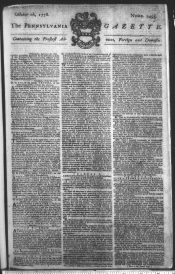Pennsylvania Constitution also celebrating 250th anniversary in 2026

Almost 250 years ago, not long after Thomas Jefferson used a quill pen at his portable writing desk to put together a first draft of the Declaration of Independence, the powers that be in Pennsylvania decided the time was ripe to put together a constitution of their own, establishing the ground rules for how “Penn’s Woods” would be run.
A state constitution was ratified in September 1776, the same month the Continental Congress gave the newly independent country the name the United States of America. One of its authors was Benjamin Franklin. Pennsylvania was one of the first states to create its own constitution and, in an age when kings and despots were the norm, it was considered to be radically small-d democratic.
Its Declaration of Rights stated that “all men are born equally free and independent and have certain, inherent and unalienable rights, amongst which are the enjoying and defending life and liberty, acquiring, profiting and protecting property and pursuing and obtaining happiness and safety.”
Before long, that constitution was considered an absolute disaster.
First, it had a powerful, unicameral legislative body and a weak executive. Legislators had the power to overturn judicial decisions it didn’t like and could limit local government in ways that were tantamount to abuse.
“There was sort of an imbalance of power,” according to Charles Jacobs, a political science and pre-law professor at Washington & Jefferson College.
So, Pennsylvania’s leaders quickly went back to the drawing board and crafted another constitution, which was ratified in 1790. Three more versions have followed in the two centuries since.
In 2026, much attention will be paid to the United States’ semiquincentennial, and the 250th anniversary of the Pennsylvania Constitution could well end up getting lost in the shuffle. That’s not surprising, considering that most of us are able to go through our days not giving the Pennsylvania Constitution – or the 49 other state constitutions – a whole lot of thought. But the Pennsylvania Constitution, and its counterparts in other states, sometimes confer rights that are not given in the U.S. Constitution.
For instance, the Pennsylvania Constitution includes an environmental rights amendment that was added in 1971, one year after the first Earth Day, stating that Pennsylvanians “have a right to clean air, pure water, and to the preservation of the natural, scenic, historic and esthetic values of the environment.” A similar right does not exist in the U.S. Constitution, and it has been cited in some of the legal fights citizens and municipalities have engaged in with the oil and gas industry over the last couple of decades.
Pennsylvania’s governing document also has an amendment protecting the “right to reputation,” that enshrines a right to due process if someone’s reputation is harmed by a state report, and a right to protect how your likeness and name are used in the marketplace. Pennsylvania’s constitution has a guarantee of gender equity, as do other state constitutions, and other state constitutions also exalt rights for crime victims, and rights to privacy, a free public education, and reproductive freedom, none of which are in the U.S. Constitution.
What becomes part of state constitutions cannot contradict what is in the U.S. Constitution, Jacobs pointed out. For instance, a state could not put in its constitution that it wants to confiscate all guns because that would violate the U.S. Constitution’s Second Amendment right to bear arms. But if a right is not spelled out in the U.S. Constitution, it can be added to a state constitution.
State constitutions “supplement rights that were available under the U.S. Constitution,” according to Ken Gormley, the president of Duquesne University and professor of law who has written a book on the Pennsylvania Constitution.
When he started teaching a course in state constitutional law in 1985, most judges were not versed in the ins-and-outs of the subject, Gormley explained. He describes Pennsylvania’s constitution as “one of the most special” of state constitutions, adding, “It’s something to be proud of.”
And he pointed out that parts of the U.S. Constitution were modeled on Pennsylvania’s constitution, and other states used the Pennsylvania constitution when they were crafting their own.
“It was one of the most influential and one of the most democratic,” Gormley said.
Pennsylvania’s constitution – and those of other states – are also much easier to amend than the U.S. Constitution. The U.S. Constitution was last amended in 1992 with the 27th Amendment. It states that congressional pay raises cannot go into effect until after the next election. In contrast, Pennsylvania’s constitution was amended as recently as 2021. Three of the new amendments deal with emergency declarations and loan applications by municipal fire and emergency services and one prohibits discrimination based on race or ethnicity.
New amendments can be added to the state’s constitution once they are approved by the Legislature twice and then get majority support from voters.
Jerry Dickinson, the dean of the University of Pittsburgh School of Law, wrote in the online State Court Report in October, “The Pennsylvania Constitution was born of a revolution and remains revolutionary.”
He continued, “Its legacy is one of experimentation – structural, doctrinal and democratic – from its radical 1776 origins to its role in the 2020 election litigation, the document and the courts interpreting it have evolved into an architecture for preserving democratic norms.”
Dickinson concluded, “This is not only Pennsylvania’s constitutional story, it is the nation’s future written in the laboratory of one commonwealth.”

